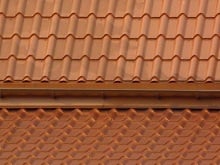6 Common Roof Types
Roofing Materials
So what goes on top? Your choice of roof material may depend on many factors, including personal taste, cost, durability, region of the country you live in, availability, and more.
This guide lists six of the most common roofing material types, along with some comments about each variety of material.
Types of Roof Materials
-

Installing an asphalt shingle roof Asphalt Shingle – Perhaps the most common form of roof surface. Relatively low-cost compared to other roofing materials. Customizable in a range of colors. “Three-tab” shingles are the most common type, and create a uniform appearance with each shingle segment appearing the same size. Twenty to thirty-year warranties are common with the three-tab shingle. In contrast, architectural shingles are thicker, heavier, and more durable than three-tab shingles, and will typically have a longer warranty. Architectural shingles differ in appearance in that they have varying sizes and shapes giving a less even appearance.
-

Characteristic ridges of standing seam metal roofing Metal – Metal roofs come in a variety of materials including tin, aluminum, copper, steel and zinc. Metal roofs are valued for their longevity and durability in the face of storms and other inclement weather. Standing seam metal roofs are named for their characteristic metal seams which connect panels to one another. Metal material roofs are typically more expensive than a shingle roof. Warranties on metal roofs can be even 50 years in duration.
-

A ceramic tile roof can last a long time. Tile – Tile can be among the heaviest of roofing materials, although light-weight tiles are also available. Tile roofs can be extremely durable, and can last many decades. Tiles can be made from clay, ceramic, concrete, synthetic materials and even porcelain. Ceramic or clay tiles can provide a Spanish or Mediterranean look to a home. Tile roofs are typically more expensive than shingles or metal, but consequently can have even longer lifespans, of even 50 to 100 years. Due to their great weight some homes’ roof framing may not be able to support a tile-covered roof. Clay tiles are typically much more expensive than concrete.
-

Classic grey slate roof, newly installed Slate – A natural stone covering well-suited to roofing, due to its resistance to water, fire and its long lifespan. Composite or synthetic slate materials are an alternative to achieve a slate appearance with a lighter and less expensive material, which can also be easier to install. Slate is among the most expensive of roofing materials, though highly valued for its beauty, longevity, and classic “historic” appearance. It is a highly fire-resistant material, though it does have the drawback of being fragile compared to other roofing materials,and making maintenance and walking on the roof for whatever reason potentially hazardous. However, slate roofing can last a century or longer, making this choice truly a “lifetime” or even “multiple-lifetime” selection. Slate is also a highly water-resistant material. Predictably, slate roofing is both high-weight and high-cost, being among the most expensive roofing surfaces. Composite and synthetic versions of slate can offer a slate appearance for a lesser cost. In cold weather areas, snow guards can be a necessity on slate and faux or imitation slate surfaces due to the surface being more slippery and leading to snow and ice sliding off the surface and falling.
-

Wood shake roof showing signs of wear and deterioration Wood (Shake and Shingle) – Wood roofing materials come in two main types, shakes and shingles. Shakes are typically split on one or both sides, and may be hand-split. They are typically thicker at the “butt end” than shingles. Cedar (often Western Red Cedar) is a common wood used for shakes. Wood shingles are generally sawn on both sides and are thinner at the butt end. Other woods used for shingles and shakes include Southern Yellow Pine, Eastern White Cedar, Cypress and Redwood species. Wood-surfaced roofs can lend an attractive, organic appearance to a home. Wood material roofs however are typically lower-longevity roofs, especially compared to more durable materials such as stone and tile. Issues with wood shingle and shake roofs include mildew and moss, rot, water penetration, brittleness due to sun and weathering, and animal damage. Wood roofs can last longer with regular maintenance and treatments using cleaners, mildew retardants, stains, bleaches, ultraviolet absorbers, and/or preservatives.
-

EPDM rubber roofing material comes in sheets Rubber – A relatively new roofing material, rubber roofs are typically applied in sheets custom-cut to fit a home, or in the form of rubber shingles. Rubber shingles tend to be more durable and less susceptible to cracking and disintegration due to weather and exposure. Rubber can offer fire resistance and generally good longevity lasting even decades. Rubber can be vulnerable to puncture, however. Also referred to as EPDM roofing (ethylene propylene diene monomer (M-class)). Typically made from recycled materials such as tires, rubber roofs are considered relatively easy to repair and maintain. Pricing is favorable too compared to other surfaces. Installation can be a challenge with rubber roof specialists less common than experts in installing other types of roofs. A poorly installed rubber roof can leak.
Besides these common roof surface materials, there are other materials used to varying degrees for roofing. These include thatched roofs, bitumens blended with plastic or rubber, fiber-cement roofing, polyurethane foam, membrane roofs such as thermoplastics, and others.
Looking for a roofer to install or repair one of these types of roofs? Try our roofing contractor guide.
Flickr images- asphalt shingle roof: David Mulder; standing seam metal roof: kshatzer; tile roof: Krzysztof Lis; slate roof: Bryn Pinzgauer; wood shake roof: KOMUnews; rubber roof: Reuse Warehouse
